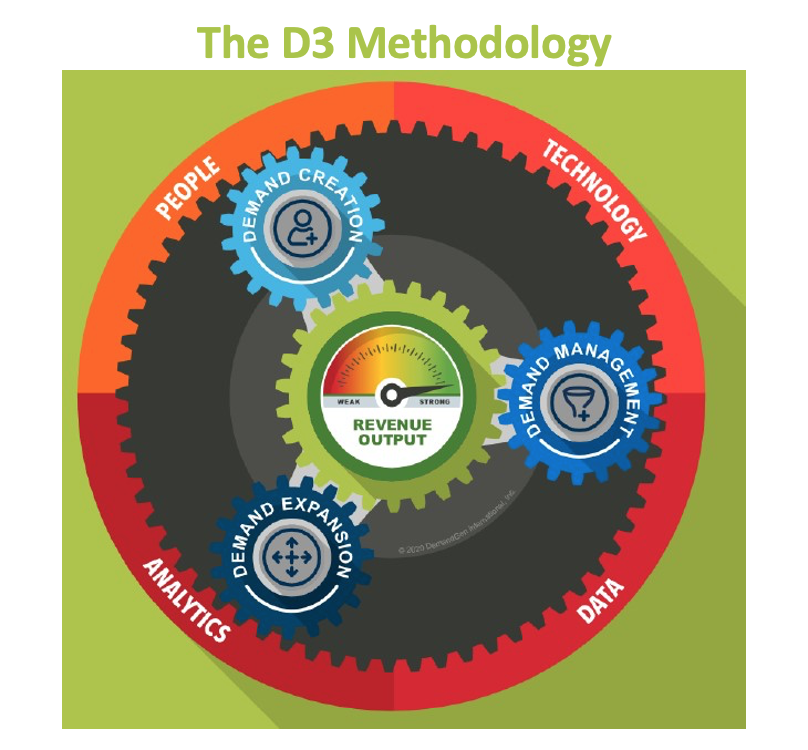
For as long as I’ve been consulting, I’ve never heard a client ask for results to take longer to achieve. These days, however, with the complexity in technology and strategy for revenue generation, “low-hanging fruit” often is much higher than it seems.
But that doesn’t mean that there aren’t quick wins to be found. In fact, there are always initial items to optimize, analyze, modify, or launch that can drive some sort of quick results. The trap to avoid is relying on quick wins instead of buckling down and building the strategies, processes, and technology necessary to really drive results at scale.
The D3 Methodology, which helps marketers identify and prioritize their initiatives and demonstrate the complexity of revenue-generation activities to others in the organization, provides a way for marketing, sales, and customer success leaders to do both at the same time through a process of iteration:

Our CEO, David Lewis, and Chief Strategy Officer, Carlos Hidalgo, have been diving deep into various aspects of the methodology. They kicked off a podcast series earlier this year introducing the D3 Methodology and sharing how marketers can apply it within their organization. I recommend checking it out if you’re interested in transforming your marketing team into a revenue-generating machine.
Two of their most recent podcasts, which discussed People and Organizational Structure and Building Strategic and Technical Skills, really caught my attention. David and Carlos talked about the role of strategy in building both a strong technological foundation and the right teams and technical skills. It becomes very clear that the functions needed to drive the revenue engine in turn drive the technology, people, and organizational needs, rather than the other way around.
However, without the D3 Methodology’s outer ring gear, which represents the four key foundational elements of People, Technology, Data, and Analytics, the necessary revenue-generation activities of Demand Creation, Demand Management, and Demand Expansion, represented by the inner gears, would never be able drive results at scale.
Building up your People and Technology through strategy and iteration
So, what happens if you don’t already have strong People and Technology foundational elements?
There is always something that can be done to drive initial results. It may be as simple as standing up the initial technology, bringing a third-party marketing services agency like DemandGen on board as your organization’s people, or scrounging up some contact lists and checking out the results on a batch-and-blast campaign. Or, it may be aligning more closely with another team, such as Sales, to help drive better results and building from there.
Quick wins, though, however you attain them, are just that: quick, and usually dirty. If you only focus on just getting the next quick win, you’ll never develop the vision, strategy, and organizational processes necessary to scale your efforts and truly move the needle.
The necessary interdependency between the Demand Creation, Management, and Expansion activities and the outer ring foundational elements means that the fastest way to scale is to design an iterative process to a) identify what is working and strengthen those activities and b) identify which areas of your Technology and People to prioritize next.
Yes, working with a partner like DemandGen can gain you the benefit of their expertise and resources to speed up the process, but there is still an element of vision and strategy that requires a depth of knowledge about your business and its levers that only comes from within.
It is essentially a feedback loop: get out a quick win while developing an overarching strategy. Use the results from those activities to find out what has worked in relation to that strategy. Prioritize and build out your People and Technology to drive more of those activities (i.e. iterate). Rinse and repeat.
This process allows you to demonstrate “quick wins” in a way that continuously builds upon itself. While the details need to be tailored to your organization and business, the overall steps are the same regardless of how strong your People and Technology may be currently.
The other two key foundational elements, Data and Analytics, do play a critical part here. For organizations starting out, however, putting in place key foundational practices — such as good governance, documentation, and process — is more important. After all, you can’t depend on reports that don’t have reliable data underneath them.
Don’t build your car before you decide how fast you want it to go
Often, I’ll see organizations purchase systems and technology that they couldn’t hope to use effectively yet, or hamstring their efforts by not putting enough resources on the right functions.
In keeping with the D3 Methodology’s planetary gear system metaphor, this would be like building a huge outer ring gear even though the inner gears aren’t big enough to reach them and engage.
The right way to do it is to build out the strategy for the outputs you want from the center gear (usually revenue) and then build out what the inner disciplines need to be around Demand Creation, Management, and Expansion to enable those. Only then can you appropriately develop your People and Technology to support those efforts.
You need to know your expected outputs to be able to design components that are strong enough to drive them. In other words, you wouldn’t build a family minivan and then attempt to retrofit it to compete in a NASCAR event.
And in the event you don’t have the right People or Technology to drive the activities in a certain area, find a partner to help you while your build up those areas.
In either case, the strategy lays the vision for prioritizing your efforts.
Don’t forget the feedback
Just like when the gears aren’t meshing with a manual transmission, you can feel it in the gear shift and the car’s movement — and you can hear the grinding.
Feedback helps determine if the foundational elements are adequately supporting the inner gears. The first point of feedback is the Analytics telling you what is happening in each one of the activities. Very often, the Data and Technology aren’t connected adequately to tie all activities back to revenue, but there is always something available to measure.
However, there are other indications of feedback that could be much more subtle and ultimately require comparing what is happening to your strategic roadmap. For example, if you are trying to launch a new initiative around holistic solution selling, but the campaigns are continuously delayed and you keep getting back content on single product features, then it is an indication that something is not meshing in the organization.
Setting up that process of gathering feedback, comparing it to your overall strategy, and adjusting accordingly can save months of grinding the gears and lack of forward motion.
Building out your revenue engine isn’t ever a small or easy job. But by taking the initial quick wins, keeping in mind where you’re going, listening to the how the engine is running, and fine-tuning as you go, the system can continue to be grown into a well-oiled machine.
DemandGen is here to provide your team with guidance and digital transformation expertise to support your demand generation initiatives. It’s what we do. Get started by downloading the D3 Methodology E-book. Then, connect with us online and let’s have a conversation about how we can help you strategically apply the D3 Methodology within your organization and build an always-on revenue engine.

Ryan Johnson develops and implements marketing automation strategies for DemandGen clients. As a DemandGen Consultant, he has helped clients across a wide range of industries to streamline and optimize their marketing and sales processes to drive measurable success and ROI.
The post Quick Wins Don’t Scale: How to Build Your People and Technology to Support Your Revenue Engine through Iteration appeared first on DemandGen.
About the Author
More Content by DemandGen

















